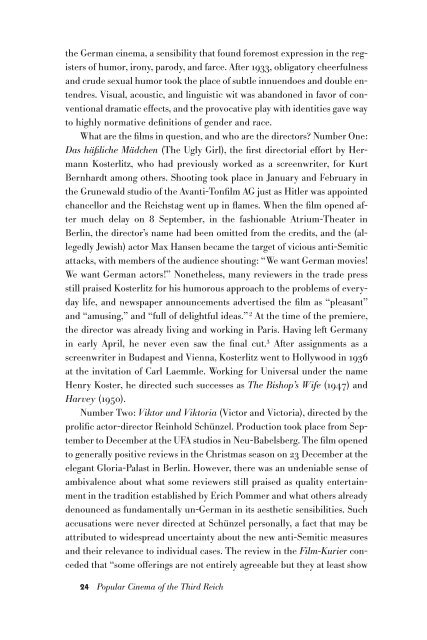You also want an ePaper? Increase the reach of your titles
YUMPU automatically turns print PDFs into web optimized ePapers that Google loves.
the German cinema, a sensibility that found foremost expression in the registers<br />
of humor, irony, parody, and farce. After 1933, obligatory cheerfulness<br />
and crude sexual humor took the place of subtle innuendoes and double entendres.<br />
Visual, acoustic, and linguistic wit was abandoned in favor of conventional<br />
dramatic effects, and the provocative play with identities gave way<br />
to highly normative definitions of gender and race.<br />
What are the films in question, and who are the directors? Number One:<br />
Das häßliche Mädchen (The Ugly Girl), the first directorial effort by Hermann<br />
Kosterlitz, who had previously worked as a screenwriter, for Kurt<br />
Bernhardt among others. Shooting took place in January and February in<br />
the Grunewald studio of the Avanti-Tonfilm AG just as Hitler was appointed<br />
chancellor and the Reichstag went up in flames. When the film opened after<br />
much delay on 8 September, in the fashionable Atrium-Theater in<br />
Berlin, the director’s name had been omitted from the credits, and the (allegedly<br />
Jewish) actor Max Hansen became the target of vicious anti-Semitic<br />
attacks, with members of the audience shouting: “We want German movies!<br />
We want German actors!” Nonetheless, many reviewers in the trade press<br />
still praised Kosterlitz for his humorous approach to the problems of everyday<br />
life, and newspaper announcements advertised the film as “pleasant”<br />
and “amusing,” and “full of delightful ideas.” 2 At the time of the premiere,<br />
the director was already living and working in Paris. Having left Germany<br />
in early April, he never even saw the final cut. 3 After assignments as a<br />
screenwriter in Budapest and Vienna, Kosterlitz went to Hollywood in 1936<br />
at the invitation of Carl Laemmle. Working for Universal under the name<br />
Henry Koster, he directed such successes as The Bishop’s Wife (1947) and<br />
Harvey (1950).<br />
Number Two: Viktor und Viktoria (Victor and Victoria), directed by the<br />
prolific actor-director Reinhold Schünzel. Production took place from September<br />
to December at the UFA studios in Neu-Babelsberg. The film opened<br />
to generally positive reviews in the Christmas season on 23 December at the<br />
elegant Gloria-Palast in Berlin. However, there was an undeniable sense of<br />
ambivalence about what some reviewers still praised as quality entertainment<br />
in the tradition established by Erich Pommer and what others already<br />
denounced as fundamentally un-German in its aesthetic sensibilities. Such<br />
accusations were never directed at Schünzel personally, a fact that may be<br />
attributed to widespread uncertainty about the new anti-Semitic measures<br />
and their relevance to individual cases. The review in the Film-Kurier conceded<br />
that “some offerings are not entirely agreeable but they at least show<br />
24 Popular Cinema of the Third Reich

















